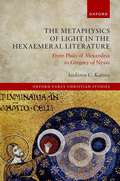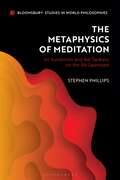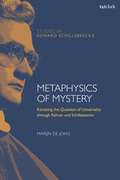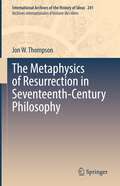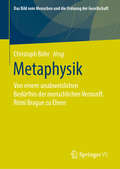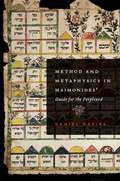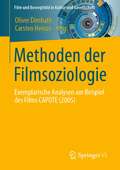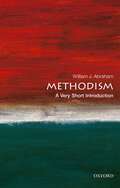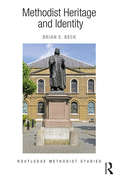- Table View
- List View
The Metaphysics of Light in the Hexaemeral Literature: From Philo of Alexandria to Gregory of Nyssa (Oxford Early Christian Studies)
by Isidoros C. KatsosThis volume critically re-evaluates the received interpretation of the nature of light in the ancient sources. Isidoros C. Katsos contests the prevalent view in the history of optics according to which pre-modernity theorized light as subordinate to sight ('oculocentrism') by examining in depth the contrary textual evidence found in early Christian texts. It shows that, from Philo of Alexandria and Origen to Basil of Caesarea and Gregory of Nyssa, the Jewish-Christian commentary tradition on the hexaemeral literature (the biblical creation narrative) reflected deeply on the nature and physicality of light for the purposes of understanding the structure and purpose of material creation. Contemplation of nature allowed early Christian thinkers to conceptualize light as the explanatory principle of vision rather than subordinated to it. Contrary to the prevalent view, the hexaemeral literature necessitates a 'luminocentric' interpretation of the theory of light of Plato's Timaeus in its reception history in the context of late antique cosmology. Hexaemeral luminocentrism invites the reader of Scripture to grasp not only the sensible properties of light, but also their causal principle as the first manifestation of the divine Logos in creation. The hexaemeral metaphysics thus provides the missing ground of meaning of the early Christian language of light.
A Metaphysics of Love: A Philosophy of Christian Life Part III
by George PattisonAs the third part of a philosophy of Christian life, A Metaphysics of Love builds on a view of Christian life as shaped by the dynamic of call, response, and promise. It argues that love is the ultimate content of this dynamic and considers how far this claim extends. Taking its bearings from Dante's vision of divine love as 'the power that moves the sun and other stars', this study explores the requirement that love is both human and cosmic, uniting being and beings. Cognizant of much recent philosophy's desire to overcome or move beyond a metaphysics of being, it examines some of the formal structures that make love possible, including language, time, social being, forgiveness, and ultimacy. Following on from the earlier volumes, extensive use is made of the idea of the poetic as the eminent mode of Christian witness, contextualized within the prose of everyday life. Heidegger provides fundamental philosophical orientation, whilst key features of love are brought to the fore through dialogue with Kierkegaard. Dante and Dostoevsky are frequent points of reference, in addition to a range of literary and religious sources, including the Scottish poet Edwin Muir. Leading scholar George Pattison concludes that the phenomenon of love requires us to articulate a metaphysics that involves both being and nothingness, thereby taking a critical position vis-à-vis both classical theism and existential atheism.
A Metaphysics of Love: A Philosophy of Christian Life Part III
by George PattisonAs the third part of a philosophy of Christian life, A Metaphysics of Love builds on a view of Christian life as shaped by the dynamic of call, response, and promise. It argues that love is the ultimate content of this dynamic and considers how far this claim extends. Taking its bearings from Dante's vision of divine love as 'the power that moves the sun and other stars', this study explores the requirement that love is both human and cosmic, uniting being and beings. Cognizant of much recent philosophy's desire to overcome or move beyond a metaphysics of being, it examines some of the formal structures that make love possible, including language, time, social being, forgiveness, and ultimacy. Following on from the earlier volumes, extensive use is made of the idea of the poetic as the eminent mode of Christian witness, contextualized within the prose of everyday life. Heidegger provides fundamental philosophical orientation, whilst key features of love are brought to the fore through dialogue with Kierkegaard. Dante and Dostoevsky are frequent points of reference, in addition to a range of literary and religious sources, including the Scottish poet Edwin Muir. Leading scholar George Pattison concludes that the phenomenon of love requires us to articulate a metaphysics that involves both being and nothingness, thereby taking a critical position vis-à-vis both classical theism and existential atheism.
The Metaphysics of Meditation: Sri Aurobindo and Adi-Sakara on the Isa Upanisad (Bloomsbury Studies in World Philosophies)
by Stephen PhillipsIn this book Stephen Phillips focuses on one of the most important poems about meditation in world literature, as understood by two of the greatest philosophers of India, one classical, one modern. Sankara's commentaries on the Upanisads are a core of the Vedanta tradition and Aurobindo is a towering figure of 20th-century Hindu thought. This is the first time their approaches have been studied together.The Isa (c. 500 BCE) an “Upanisad” belongs to a genre of “adhyatmika” learning-concerning self and consciousness-in early Indian literature. According to the Ancient Indian tradition of yoga, meditation is antithetical to willful bodily and mental action. Breathing is all you do. In the conception of the Isa Upanisad, we are told that the best that comes from meditation is because of what the “Lord” is. In Sankara's interpretation it comes to block out the little “you,” whereas according to Aurobindo it comes as a divine connection, an occult “Conscious Force” belonging to truer part of oneself, atman, and an “opening” to that self's native energy. Framed around Aurobindo's translation of each of the Isa's eighteen verses, along with a translation of each verse, Phillips follows a different reading of Sankara as laid out in his commentary. All this is done against the backdrop of modern scholarship. Convergences and divergences of these streams are the focus throughout. Appendix A presents the Upanisad with the two readings side by side.This book traces a worldview and consonant yoga teaching common to two authors who are typically taken to be oceans apart, not only chronologically but in intellectual stance. Addressing a huge gap in the contemporary literature on meditation in the Hindu traditions, Phillips presents a compelling new way of thinking about meditation in the Advaita Vedanta philosophy and Upanisad.
The Metaphysics of Meditation: Sri Aurobindo and Adi-Sakara on the Isa Upanisad (Bloomsbury Studies in World Philosophies)
by Stephen PhillipsIn this book Stephen Phillips focuses on one of the most important poems about meditation in world literature, as understood by two of the greatest philosophers of India, one classical, one modern. Sankara's commentaries on the Upanisads are a core of the Vedanta tradition and Aurobindo is a towering figure of 20th-century Hindu thought. This is the first time their approaches have been studied together.The Isa (c. 500 BCE) an “Upanisad” belongs to a genre of “adhyatmika” learning-concerning self and consciousness-in early Indian literature. According to the Ancient Indian tradition of yoga, meditation is antithetical to willful bodily and mental action. Breathing is all you do. In the conception of the Isa Upanisad, we are told that the best that comes from meditation is because of what the “Lord” is. In Sankara's interpretation it comes to block out the little “you,” whereas according to Aurobindo it comes as a divine connection, an occult “Conscious Force” belonging to truer part of oneself, atman, and an “opening” to that self's native energy. Framed around Aurobindo's translation of each of the Isa's eighteen verses, along with a translation of each verse, Phillips follows a different reading of Sankara as laid out in his commentary. All this is done against the backdrop of modern scholarship. Convergences and divergences of these streams are the focus throughout. Appendix A presents the Upanisad with the two readings side by side.This book traces a worldview and consonant yoga teaching common to two authors who are typically taken to be oceans apart, not only chronologically but in intellectual stance. Addressing a huge gap in the contemporary literature on meditation in the Hindu traditions, Phillips presents a compelling new way of thinking about meditation in the Advaita Vedanta philosophy and Upanisad.
Metaphysics of Mystery: Revisiting the Question of Universality through Rahner and Schillebeeckx (T&T Clark Studies in Edward Schillebeeckx)
by Marijn de JongHow can we theologically reflect on universality in a world that increasingly focuses on particularities and differences? Marijn de Jong argues that the question of universality calls for a reconceptualised form of metaphysical theology, which he finds in the work of Karl Rahner and Edward Schillebeeckx. Casting a new light on these theologians, De Jong demonstrates that their methods contain a dialectical interrelation of hermeneutics and metaphysics. An interrelation which seemingly has been lost in more recent hermeneutical theology, Rahner and Schillebeeckx carefully balance particularity and universality without falling prey to relativist or absolutist ways of reasoning. By analyzing fundamental themes such as experience and interpretation, nature and grace, faith and reason, and intelligibility and mystery, De Jong reveals the modest theological metaphysics that lies at the heart of their methods. This critical retrieval demonstrates the enduring relevance of these thinkers and opens up new avenues of thought for theologians that do not want to shy away from the difficult question of the universality of God.
Metaphysics of Mystery: Revisiting the Question of Universality through Rahner and Schillebeeckx (T&T Clark Studies in Edward Schillebeeckx)
by Marijn De JongHow can we theologically reflect on universality in a world that increasingly focuses on particularities and differences? Marijn de Jong argues that the question of universality calls for a reconceptualised form of metaphysical theology, which he finds in the work of Karl Rahner and Edward Schillebeeckx. Casting a new light on these theologians, De Jong demonstrates that their methods contain a dialectical interrelation of hermeneutics and metaphysics. An interrelation which seemingly has been lost in more recent hermeneutical theology, Rahner and Schillebeeckx carefully balance particularity and universality without falling prey to relativist or absolutist ways of reasoning. By analyzing fundamental themes such as experience and interpretation, nature and grace, faith and reason, and intelligibility and mystery, De Jong reveals the modest theological metaphysics that lies at the heart of their methods. This critical retrieval demonstrates the enduring relevance of these thinkers and opens up new avenues of thought for theologians that do not want to shy away from the difficult question of the universality of God.
The Metaphysics of Resurrection in Seventeenth-Century Philosophy (International Archives of the History of Ideas Archives internationales d'histoire des idées #241)
by Jon W. ThompsonThis book provides a new account of the emergence of the philosophy of personal identity in the early modern period. Reflection on personal identity is often thought to have begun in earnest with John Locke’s famous consciousness-based account, published in the 2nd Edition of the Essay in 1694. The present work argues that we ought to understand modern notions of personal identity, including Locke’s own, as emerging from within debates about the metaphysics of resurrection across the seventeenth century. It recovers and analyses theories of personal identity and resurrection in Locke and Leibniz, as well as largely-forgotten theories from the Cambridge Platonists, Thomas Jackson, and Francisco Suárez. The book narrates a time of radical change in conceptions of personal identity: the period begins with a near-consensus on hylomorphism, according to which the body is an essential metaphysical part of the person. The re-emergence of platonism in the period then undermines the centrality of the body for personal identity, and this lays the groundwork for a more thoroughly ‘psychological’ account of personal identity in Locke. This work represents the first scholarly study to thoroughly situate early modern conceptions of personal identity, embodiment, and the afterlife within the context of late scholasticism. Finally, due to its focus on the arguments of the authors in question, the work will be of interest to philosophers of religion as well as historians of philosophy.
Metaphysik: Von einem unabweislichen Bedürfnis der menschlichen Vernunft. Rémi Brague zu Ehren (Das Bild vom Menschen und die Ordnung der Gesellschaft)
Ein Leben lang leidet der Mensch an der nie zu überwindenden Endlichkeit seiner Vernunft, die ihn heftig mit Fragen bedrängt, zu deren Beantwortung sie selbst gar nicht in der Lage ist. Im Blick auf den Versuch, dieses Paradoxon aufzulösen, dass nämlich einerseits das metaphysische Bedürfnis der Vernunft zwar von dieser nicht aus eigener Kraft zufriedengestellt werden kann, andererseits aber diese Einsicht keineswegs ihr bohrendes Fragen zum Schweigen bringt, wird die Verführung nachvollziehbar, das Kind mit dem Bade auszuschütten und der Vernunft rundweg und grundsätzlich eine tragfähige lebens- und handlungsleitende Kraft abzusprechen. Große Teile der Postmoderne sind von diesem tiefen Misstrauen, das den Abschied von aller Vernunft zu rechtfertigen scheint, geprägt. Die Alternative zu ihrer Verabschiedung im Aufweis der Möglichkeit – ja Notwendigkeit – von Metaphysik auch und gerade angesichts einer stets in ihrer Endlichkeit gefangenen Vernunft wird in diesem Buch gezeichnet.
Method and Metaphysics in Maimonides' Guide for the Perplexed (AAR Reflection and Theory in the Study of Religion)
by Daniel DaviesThis book investigates the substance and presentation of major metaphysical themes in Maimonides' Guide for the Perplexed. Using rigorous philosophy it seeks to refute the view that the Guide hides an ''esoteric'' philosophical meaning beneath a traditional veneer, and offers a new explanation of his esotericism.
Methoden der Filmsoziologie: Exemplarische Analysen am Beispiel des Films CAPOTE (2005) (Film und Bewegtbild in Kultur und Gesellschaft)
by Oliver Dimbath Carsten HeinzeDie Beiträge dieses Bandes gehen aus einem Symposion zur Analyse des Spielfilms CAPOTE (2005) hervor, das Vertreterinnen und Vertreter unterschiedlicher filmsoziologischer Methoden und Zugänge zusammengebracht hat. Die Fokussierung auf einen Film gewährt einen vergleichenden Blick auf verschiedene Verfahren und die Reichweite ihrer Interpretations- und Deutungspotenziale. Unter den behandelten Ansätzen finden sich Positionen der filmgestützten Interaktionsanalyse, der Seduktionstheorie oder der biografischen Filmanalyse.
Methoden kulturvergleichender Sozialforschung: Eine Einführung
by Susanne Rippl Christian SeipelDer Kulturvergleich erlangt im Zuge der Globalisierung und Internationalisierung vieler Lebensbereiche eine zunehmende Bedeutung. Deutschsprachige Lehrbücher zu diesem Thema gibt es jedoch kaum. Diese Lücke schließt das vorliegende Buch. Das Ziel des Bandes ist es, eine praxisorientierte Einführung in die Methoden kulturvergleichender Forschung vorzulegen. Dabei werden insbesondere die Möglichkeiten und Grenzen kulturvergleichender Surveyforschung behandelt. Das Buch bietet eine solide Basis für einen kritischen Umgang mit kulturvergleichenden Studien, es vermittelt aber auch grundlegende Kenntnisse für die eigene Durchführung kulturvergleichender Forschung.
Methoden kulturvergleichender Sozialforschung: Eine Einführung
by Susanne Rippl Christian SeipelDieses Lehrbuch bietet eine leicht verständliche und gut lesbare Einführung in inhaltliche, methodische und technische Fragen der kulturvergleichenden Forschung.
Methodism and the Rise of Popular Literary Criticism: Reviewing the Revival (Routledge Methodist Studies Series)
by Brett McInellyThis book examines how Methodism and popular review criticism intersected with and informed each other in the eighteenth century. Methodism emerged at a time when the idea of a ‘public square’ was taking shape, a process facilitated by the periodical press. Perhaps more so than any previous religious movement, Methodism, and the publications associated with it, received greater scrutiny largely because of periodical literature and the emergence of popular review criticism. The book considers in particular how works addressing Methodism were discussed and critiqued in the era’s two leading literary periodicals – The Monthly Review and The Critical Review. Focusing on the period between 1749 and 1789, the study encompasses the formative years of popular review criticism and some of the more dramatic moments in the textual culture of early Methodism. The author illustrates some of the specific ways these review journals diverged in their critical approaches and sensibilities as well as their politics and religious opinions. The Monthly’s and the Critical’s responses to the Methodists’ own publishing efforts as well as the anti-Methodist critique are shown to be both multifaceted and complex. The book critically reflects on the pretended neutrality, reasonableness, and objectivity of reviewers, who at times found themselves negotiating between the desire to regulate literary tastes and the impulse to undermine the Methodist revival. It will be relevant to scholars of religion, history and literary studies with an interest in Methodism, print culture, and the eighteenth century.
Methodism and the Rise of Popular Literary Criticism: Reviewing the Revival (Routledge Methodist Studies Series)
by Brett McInellyThis book examines how Methodism and popular review criticism intersected with and informed each other in the eighteenth century. Methodism emerged at a time when the idea of a ‘public square’ was taking shape, a process facilitated by the periodical press. Perhaps more so than any previous religious movement, Methodism, and the publications associated with it, received greater scrutiny largely because of periodical literature and the emergence of popular review criticism. The book considers in particular how works addressing Methodism were discussed and critiqued in the era’s two leading literary periodicals – The Monthly Review and The Critical Review. Focusing on the period between 1749 and 1789, the study encompasses the formative years of popular review criticism and some of the more dramatic moments in the textual culture of early Methodism. The author illustrates some of the specific ways these review journals diverged in their critical approaches and sensibilities as well as their politics and religious opinions. The Monthly’s and the Critical’s responses to the Methodists’ own publishing efforts as well as the anti-Methodist critique are shown to be both multifaceted and complex. The book critically reflects on the pretended neutrality, reasonableness, and objectivity of reviewers, who at times found themselves negotiating between the desire to regulate literary tastes and the impulse to undermine the Methodist revival. It will be relevant to scholars of religion, history and literary studies with an interest in Methodism, print culture, and the eighteenth century.
Methodism and the Southern Mind, 1770-1810 (Religion in America)
by Cynthia Lynn LyerlyThis book looks at the role of Methodism in the Revolutionary and early national South. When the Methodists first arrived in the South, Lyerly argues, they were critics of the social order. By advocating values traditionally deemed "feminine," treating white women and African Americans with considerable equality, and preaching against wealth and slavery, Methodism challenged Southern secular mores. For this reason, Methodism evoked sustained opposition, especially from elite white men. Lyerly analyzes the public denunciations, domestic assaults on Methodist women and children, and mob violence against black Methodists. These attacks, Lyerly argues, served to bind Methodists more closely to one another; they were sustained by the belief that suffering was salutary and that persecution was a mark of true faith.
Methodism in Australia: A History (Routledge Methodist Studies Series)
by Hilary M. Carey Glen O'BrienMethodism has played a major role in all areas of public life in Australia but has been particularly significant for its influence on education, social welfare, missions to Aboriginal people and the Pacific Islands and the role of women. Drawing together a team of historical experts, Methodism in Australia presents a critical introduction to one of the most important religious movements in Australia's settlement history and beyond. Offering ground-breaking regional studies of the development of Methodism, this book considers a broad range of issues including Australian Methodist religious experience, worship and music, Methodist intellectuals, and missions to Australia and the Pacific.
Methodism in Australia: A History (Routledge Methodist Studies Series)
by Hilary M. Carey Glen O’BrienMethodism has played a major role in all areas of public life in Australia but has been particularly significant for its influence on education, social welfare, missions to Aboriginal people and the Pacific Islands and the role of women. Drawing together a team of historical experts, Methodism in Australia presents a critical introduction to one of the most important religious movements in Australia's settlement history and beyond. Offering ground-breaking regional studies of the development of Methodism, this book considers a broad range of issues including Australian Methodist religious experience, worship and music, Methodist intellectuals, and missions to Australia and the Pacific.
Methodism in the American Forest
by Russell E. RicheyWinner of the 2015 Saddleback Selection Award from the Historical Society of The United Methodist Church During the nineteenth century, camp meetings became a signature program of American Methodists and an extraordinary engine for their remarkable evangelistic outreach. Methodism in the American Forest explores the ways in which Methodist preachers interacted with and utilized the American woodland, and the role camp meetings played in the denomination's spread across the country. Half a century before they made themselves such a home in the woods, the people and preachers learned the hard way that only a fool would adhere to John Wesley's mandate for preaching in fields of the New World. Under the blazing American sun, Methodist preachers sought and found a better outdoor sanctuary for large gatherings: under the shade of great oaks, a natural cathedral where they held forth with fervid sermons. The American forests, argues Russell E. Richey, served the preachers in several important ways. Like a kind of Gethesemane, the remote, garden-like solitude provided them with a place to seek counsel from the Holy Spirit. They also saw the forest as a desolate wilderness, and a means for them to connect with Israel's years after the Exodus and Jesus's forty days in the desert after his baptism by John. The dauntless preachers slashed their way through, following America's expanding settlement, and gradually sacralizing American woodlands as cathedral, confessional, and spiritual challenge-as shady grove, as garden, and as wilderness. The threefold forest experience became a Methodist standard. The meeting of Methodism's basic governing body, the quarterly conference, brought together leadership of all levels. The event stretched to two days in length and soon great crowds were drawn by the preaching and eventually the sacraments that were on offer. Camp meetings, if not a Methodist invention, became the movement's signature, a development that Richey tracks throughout the years that Methodism matured, to become a central denomination in America's religious landscape.
Methodism in the American Forest
by Russell E. RicheyWinner of the 2015 Saddleback Selection Award from the Historical Society of The United Methodist Church During the nineteenth century, camp meetings became a signature program of American Methodists and an extraordinary engine for their remarkable evangelistic outreach. Methodism in the American Forest explores the ways in which Methodist preachers interacted with and utilized the American woodland, and the role camp meetings played in the denomination's spread across the country. Half a century before they made themselves such a home in the woods, the people and preachers learned the hard way that only a fool would adhere to John Wesley's mandate for preaching in fields of the New World. Under the blazing American sun, Methodist preachers sought and found a better outdoor sanctuary for large gatherings: under the shade of great oaks, a natural cathedral where they held forth with fervid sermons. The American forests, argues Russell E. Richey, served the preachers in several important ways. Like a kind of Gethesemane, the remote, garden-like solitude provided them with a place to seek counsel from the Holy Spirit. They also saw the forest as a desolate wilderness, and a means for them to connect with Israel's years after the Exodus and Jesus's forty days in the desert after his baptism by John. The dauntless preachers slashed their way through, following America's expanding settlement, and gradually sacralizing American woodlands as cathedral, confessional, and spiritual challenge-as shady grove, as garden, and as wilderness. The threefold forest experience became a Methodist standard. The meeting of Methodism's basic governing body, the quarterly conference, brought together leadership of all levels. The event stretched to two days in length and soon great crowds were drawn by the preaching and eventually the sacraments that were on offer. Camp meetings, if not a Methodist invention, became the movement's signature, a development that Richey tracks throughout the years that Methodism matured, to become a central denomination in America's religious landscape.
Methodism: A Very Short Introduction (Very Short Introductions)
by William J. AbrahamBeginning as a renewal movement within Anglicanism in the eighteenth century, Methodism had become the largest Protestant denomination in the USA in the nineteenth century, and is today one of the most vibrant forms of Christianity. Representing a complex spiritual and evangelistic experiment that involves a passionate commitment to worldwide mission, it covers a global network of Christian denominations. In this Very Short Introduction William J. Abraham trace Methodism from its origins in the work of John Wesley and the hymns of his brother, Charles Wesley, in the eighteenth century, right up to the present. Considering the identity, nature, and history of Methodism, Abraham provides a fresh account of the place of Methodism in the life and thought of the Christian Church. Describing the message of Methodism, and who the Methodists are, he also considers the practices of Methodism, and discusses the global impact of Methodism and its decline in the homelands. Finally Abraham looks forward, and considers the future prospects for Methodism. ABOUT THE SERIES: The Very Short Introductions series from Oxford University Press contains hundreds of titles in almost every subject area. These pocket-sized books are the perfect way to get ahead in a new subject quickly. Our expert authors combine facts, analysis, perspective, new ideas, and enthusiasm to make interesting and challenging topics highly readable.
Methodism: A Very Short Introduction (Very Short Introductions)
by William J. AbrahamBeginning as a renewal movement within Anglicanism in the eighteenth century, Methodism had become the largest Protestant denomination in the USA in the nineteenth century, and is today one of the most vibrant forms of Christianity. Representing a complex spiritual and evangelistic experiment that involves a passionate commitment to worldwide mission, it covers a global network of Christian denominations. In this Very Short Introduction William J. Abraham trace Methodism from its origins in the work of John Wesley and the hymns of his brother, Charles Wesley, in the eighteenth century, right up to the present. Considering the identity, nature, and history of Methodism, Abraham provides a fresh account of the place of Methodism in the life and thought of the Christian Church. Describing the message of Methodism, and who the Methodists are, he also considers the practices of Methodism, and discusses the global impact of Methodism and its decline in the homelands. Finally Abraham looks forward, and considers the future prospects for Methodism. ABOUT THE SERIES: The Very Short Introductions series from Oxford University Press contains hundreds of titles in almost every subject area. These pocket-sized books are the perfect way to get ahead in a new subject quickly. Our expert authors combine facts, analysis, perspective, new ideas, and enthusiasm to make interesting and challenging topics highly readable.
The Methodist Church in Poland: Activity and Political Conditions, 1945–1989 (Routledge Methodist Studies Series)
by Ryszard MichalakThis book explores the development and activity of the Methodist Church in Poland, focusing on the political conditions under which it functioned after 1945. In particular it considers the role of party and state power, and the nature and impact of religious policy towards the Church. The chapters touch on organizational issues, missionary activity, and key figures in the recent history of the Church. Drawing on more than 20 years of research on Polish Methodism and the increasing availability of archival material, this volume will be of interest to scholars of religion, politics and history.
The Methodist Church in Poland: Activity and Political Conditions, 1945–1989 (Routledge Methodist Studies Series)
by Ryszard MichalakThis book explores the development and activity of the Methodist Church in Poland, focusing on the political conditions under which it functioned after 1945. In particular it considers the role of party and state power, and the nature and impact of religious policy towards the Church. The chapters touch on organizational issues, missionary activity, and key figures in the recent history of the Church. Drawing on more than 20 years of research on Polish Methodism and the increasing availability of archival material, this volume will be of interest to scholars of religion, politics and history.
Methodist Heritage and Identity (Routledge Methodist Studies Series)
by Brian E. BeckBrian Beck has had a long and distinguished career in Methodist studies, having additionally served as President of the UK Methodist Conference and helped lead the international Oxford Institute of Methodist Theological Studies. This book is the first time that Beck’s seminal work on Methodism has been gathered together. It includes eighteen essays from the last twenty-five years, covering many different aspects of Methodist thought and practice. This collection is divided into two main sections. Part I covers Methodism’s heritage and its implications, while Part II discusses wider issues of Methodism’s identity. The chapters themselves examine the work of key figures, such as John Wesley and J. E. Rattenbury, as well as past and present forms of Methodist thought and practice. As such, this book is important reading for any scholar of Methodism as well as students and academics of religious studies and theology more generally.
